-
Tango Charlie and Foxtrot Romeo by John Varley
A couple of years ago I tried reading some of John Varley novels, but didn’t find them interesting. Reading his short stories is a completely different things. There are so many interesting stories from him the 70s and 80s, and this is just one among many in the big collection The John Varley Reader.
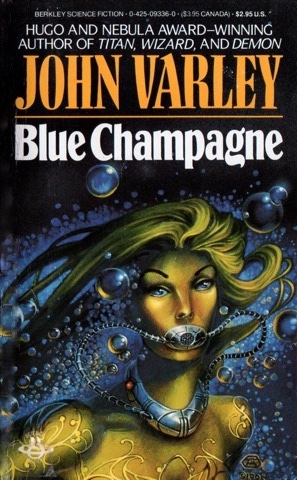
The basic setup for this story is really something else. A young girl stranded alone on an abandoned space station with only some dogs and plenty of alcohol for companionship. After years of living like this a Lunar police officer manages to get in contact with her, after it is discovered that someone is actually alive aboard this station that is about to crash. The mystery of who she is and why she is alive on the space station reveals a fascinating back story about a terrible virus that ravaged decades ago.
It is a very tragic and sad story, but not overly so because Varley often writes with a little added humor and lightheartedness. It wasn’t a particularly sad reading experience even though the actual story is.
Read in The John Varley Reader
Originally published in Blue Champagne
Rating: 4 -
Saving Galileo by Sean McMullen
Sean McMullen is an Australian author I have just recently discovered and have been very impresses with basically every short story I have read of him so far. His collection “Dreams of the Technarion” is worth checking out.
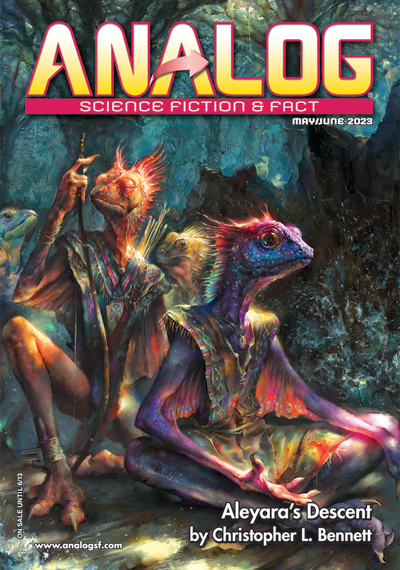
The story follows Lars who has worked as an engineer on a large telescope project located on the Moon. He goes on a sort of date with a woman who turns out to be a contract killer on a mission to kill him. Somehow Lars is neither surprised nor very upset about this. The assassin can’t help being curious about why this seemingly harmless engineer has a price on his head, so Lars gets to tell his story.
McMullen manages to create an engaging story even though it is on the surface just two people talking. The main character even acknowledges this directly:
I have found that questions are the best way to explain a difficult idea. Do an info-dump, and people’s eyes glaze over. Force them to follow a trail of reasoning, and you have a convert.
p. 117
Both characters are interesting and the actual mystery about what Lars know and why someone wants him dead was well done and original.
Read in Analog May/June 2023
Rating: 4 -
Piggyback Girl by M. H. Ayinde
A common thing for science fiction stories is to take a current trend and extrapolate it into a more extreme form. This short story looks at social media influencers in a future where the technology allows a bit more following than today.
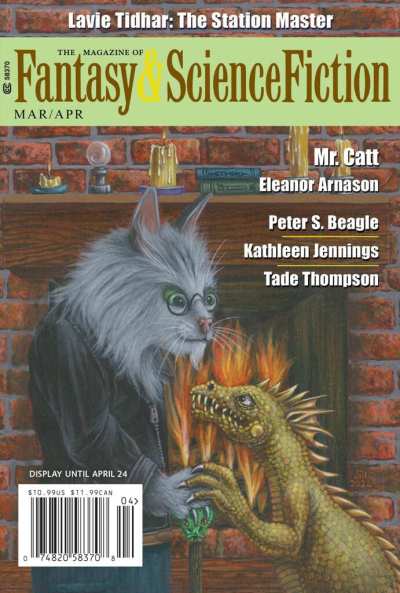
Amber is a popular influencer with many followers. She gets lured into taking it to the next level with an operation that gives her an implant in her brain, allowing her follows to hear, see and feel literally everything she feels. Anything just short of reading her thoughts. At first she is horrified, she didn’t read the fine print in the contract, but accepts her situation since it is only 6 months.
Most of the story is pretty straightforward and somewhat predictable with its message, however it takes a rather dark turn in the end. A good story but I was slightly annoyed that the whole premise relied too much on Amber not reading anything about what she actually signed up for. I thought that could have been handled better.
Read in Fantasy & Science Fiction, March/April 2023
Rating: 3 -
Immune Response by Robert R. Chase
This was a good and very Analog-_ish_ story with believable scientists doing science. Which I always love.
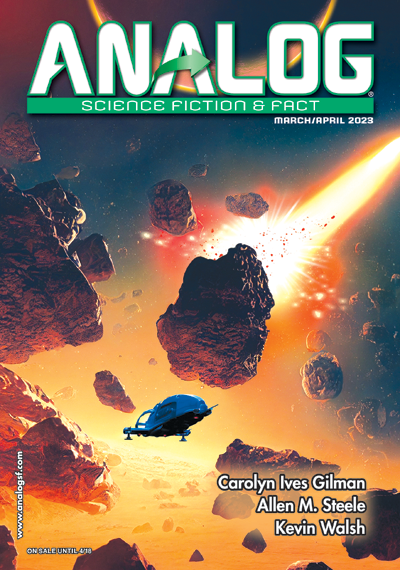
A young professor is given some papers from his former supervisor after his death. Among the papers is a long list of various mathematicians, physicists and cosmologists from around the world. Many names with a checkmark next to them, some without. One of the names is his own - without a checkmark. At first he tries to ignore it, but he becomes increasingly intrigued by the puzzle.
This will be a slight spoiler for the story, but I think most readers will be able to see broadly where this is going. The names that has a mark have all died - some of natural causes and others by more strange circumstances, usually at a young age. All were doing interesting work in their fields, though without any clear link. It is revealed that all the scientists were doing work that could potentially lead to the invention of time travel. And something is trying to prevent that of happening.
This premise have been done at least a couple of times before, but that doesn’t take anything away from Chase who has written an engaging and thought provoking story about the limits of scientific research.
Read in Analog March/April 2023
Rating: 3 -
Gravesend, or, Everyday Life in the Anthropocene by Paul McAuley
McAuley sets this long novella at around 2060 in a world trying to deal with climate change, though that is not central to the story - merely an inevitable pre-condition.
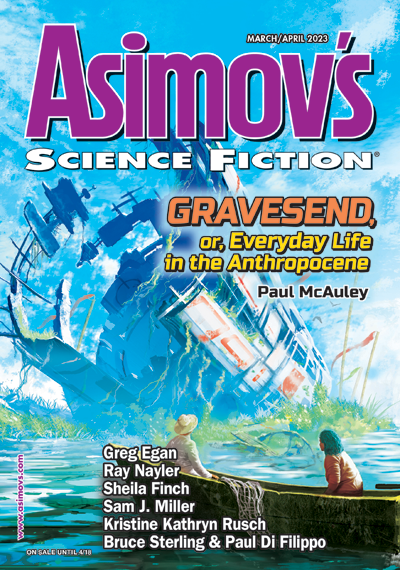
The plot moves rather slowly and mostly concerns world building, with a few somewhat crude jabs at what people in our present time did wrong. We follow Rose who suffers from being a victim to some sort of psychic weapon. She knows of a clinic in Czech Republic that might have a treatment, but she needs some money first. She comes across some information about a stack of soul chips that could be valuable. The so called soul chips was an attempt for people to upload their minds into a chip in the hope of living forever once the technology has advanced enough. Though it becomes pretty clear that it was more or less a scam based on crude machine learning creating superficial simulations of human personalities. However, in this lower-tech future some collectors find them intriguing.
This story is really mostly about our present and less about this future. The characters have plenty of conversations about our time and how people were back then, their hopes for the future and naive outlook that things could just continue forever. I think McAuley gets across what he wants to say without being overly didactic and still giving the reader an interesting story on its own.
Read in Asimov’s March/April 2023
Rating: 3 -
The Plus One by Marie Vibbert
A straight forward murder mystery on Mars. Except it is not outright murder, but someone is still responsible.
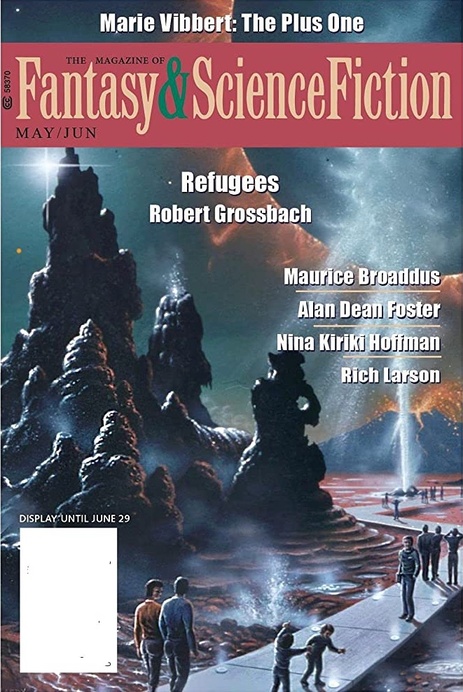
The setting is a settlement on Mars in its early stages and the story follows Blaine who is working as a marshall, serving the role of the practically missing law enforcement. A dead body of a woman turns up and he sets of to investigate how and why.
Might be a slight spoiler, but there is no murderer per se, but Blaine uncovers an unjust cooperate system that fails to take proper care under tragic circumstances. The woman was married to an employee stationed on Mars, but when he died of an illness, she lost any funding or rights to keep alive on Mars. There is a fine point to the story here about unemphatic cooperations not willing to take responsibility if they are not legally required to, but I had a somewhat hard time accepting this premise. If we ever get a settlement on Mars and have people employed on work contracts there, I am pretty certain lawyers and insurance companies would write up a plethora of clauses to handle every possible and impossible scenario. That aside still a decent story.
Read in Forever Magazine, March 2023
Originally published in F&SF May/June 2021
Rating: 2+ -
The Nameless Dead by Kristine Kathryn Rusch
Rusch is known to write about a future with advanced spacefare and aliens, but where some of the injustices in todays world still lives on. I recently wrote about “The Impossibles” with that theme. In this story the narrator isn’t exactly a likeable person that wants to fight injustice - though she might end up doing just that.

The narrator is a woman who works as a private detective, sort of, on some planetary settlement. She ended up there after she left her life and family on Earth behind when she signed up for a voyage across the galaxy. She signed all the waivers on the consequences of time dilation, but it took her a while to actually understand it - and then there was no going back. Now she offers investigative services to other people in a similar situation, by going through various data sources for information on their families back on Earth where at least a 100 years have passed. She gets a big case where she is tasked with investigating hundreds of travelers, which unveils a much greater crime that she is used to dealing with.
Rusch has made an interesting choice by having a narrator that is rather unlikable. She has a lot of self-hate but no real regrets on leaving behind her son and husband. The effect of this is that we don’t really have sympathy for her in the beginning, because she just have to live with the consequences of her actions, but through her investigations we hear of people who have ended up in the same situation as her having lost their families to the effects of time dilation - except they claim to not have done so knowingly.
The emotional impact isn’t quite on the same level as that famous scene in the movie Interstellar, but the story pushes the same buttons in that regard.
Read in Asimov’s March/April 2023
Rating: 3+ -
Death Game by David Gerrold
A reality tv show where it is literally about life and death is not a new idea in science fiction, and this story might not be very original, it still handles the subject in a very believable and engaging way.
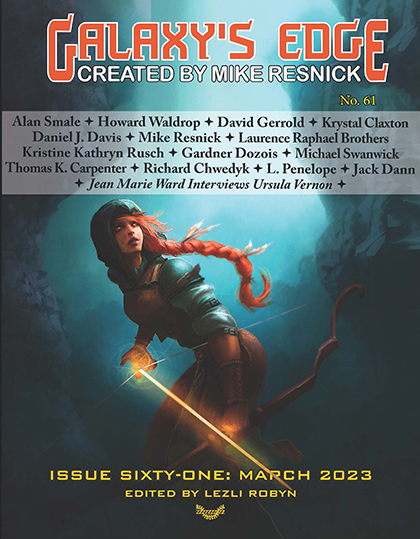
The concept introduced here is pretty simple. 1000 people sign up for the event, everybody has to swallow a pill and a random person dies. Proceed to the next round to win more money or quit and keep your winnings. Rinse and repeat. The story is told by one half of a couple who entered together, so we know at least one of them survived, but how it all develops throughout the several months long tv program kept me hooked from start to finish.
It is sort of predictable how things escalates, how they have doubts as the odds gets worse and how they get hooked on the thrill so they can’t stop even though their winnings are already way beyond their initial goal. Even though the story didn’t throw any huge surprises at me - the ending being a slight exception but not huge - the execution from Gerrold is just very well done. I was hooked like it was an actual game show I was watching and everything surrounding it felt very realistic and plausible. I wouldn’t completely rule out such a reality show in some future at least.
Read in Galaxy’s Edge March 2023
Rating: 4 -
The Repair by Mark D. Jacobsen
This short story is set in a cyberpunkish future with an internet controlled by spambots and even the smallest misstep on social media, will get a person “cancelled” into oblivion.

We follow Joel who works odd jobs with various technical repairs. Over the years he has managed to get quite a few augmented upgrades on himself to be able to do advanced tasks, but his clients are mostly on the edges of society. He is tasked to do a repair on a humanlike robot by a very nervous and skeptical woman. She will not give him any information about herself or the reason for the repair job. Joel has his own sources though and manages to get enough data on her to know her name and that she posted something possibly racist on Twitter, which has ruined her life because automated bots make sure that every misstep online is never forgotten and everything she tries to do online is hampered by AI bots. Joel has his own similar baggage and even though she doesn’t ask for it, he tries to help her more than just repairing her robot.
In a relatively few pages, the author manages to create a bleak and dystopian future with no digital privacy and “cancel culture” is taken to extremes and out of control by automated bots. It is not a story that gives all the answers, give complete background stories or even resolve all plot threads, but it doesn’t need to. There is plenty of depth in this well written short story.
Read in Asimov’s March/April 2023
Rating: 3+ -
Silo, Sweet Silo by James Castles
This story felt a bit like the classic nuclear scare stories from the 50s updated to the 21st century.
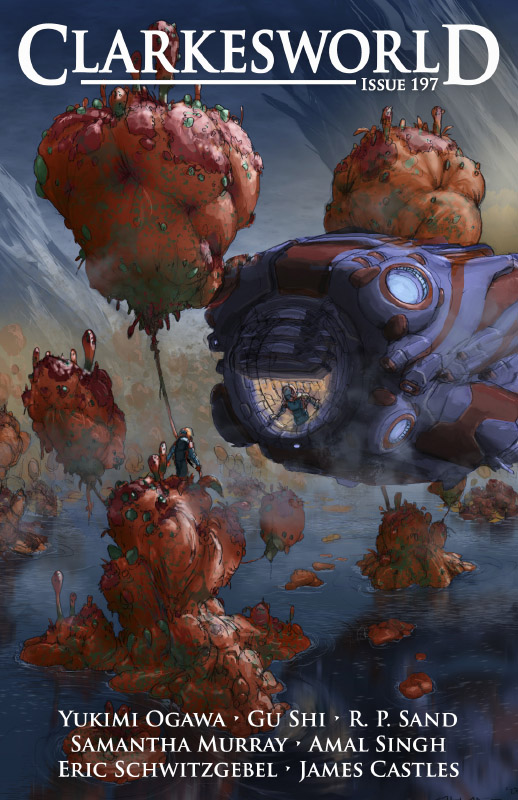
In some undetermined future destroyed by what I would assume was a nuclear war, a group of humans approaches a missile silo base station still in operation. It is operated by an AI and the story is told from its perspective in second person (which was bit of a weird choice in my opinion, but it didn’t detract from the experience).
The humans are seeking food and shelter and the silo can provide it - on one condition. It needs a human operator to fulfill its ultimate purpose: launch the missile towards the enemy. The humans are not really keen on that, thinking the world have seen enough death. They do agree to postpone the issue a month while the humans are allowed to get settled in the silo base. As the story moves forward, the AI running the silo starts having doubts on its programmed purpose in “life”.
I don’t know if the author was inspired by the classic Theodore Sturgeon story “Thunder and Roses”, but it many ways it reminded me of that story - though not as grim.
Read in Clarkesworld February 2023
Rating: 3+